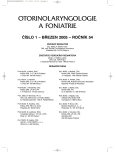Fistulas and Cysts from the First Branchial Grove
Authors:
Z. Kabelka; J. Fajstavr
Authors‘ workplace:
Klinika ušní, nosní a krční 2. LF UK a FN Motol, Praha
subkatedra pro dětskou otorinolaryngologii IPVZ, Praha
přednosta doc. MUDr. Z. Kabelka
Published in:
Otorinolaryngol Foniatr, 54, 2005, No. 1, pp. 23-26.
Category:
Original Article
Overview
Summary:
Anomalies of the first branchial groove are uncomon. Duplication of it can result in persistance of a tract that extends from the skin of the upper neck to the external auditory canal. Duplication type II (ectodermal and mesodermal/cartilaginous origin) has a close relationship to the facial nerve. Duplication type I has ectodermal origin only and pass superior to facial nerve. The anomalies have variable internal orificium (it is of a great diagnostic value), but even large ostia are not found many times. In lying, chilled out children a careful otomicroscopy is necessary. Total surgical excision is the method of choice and the standard incision for a parotidectomy should be used. The first step must be identification of the facial nerve. Surgery should be so soft to safe other structures beeing in contact. In 5 cases during last two years – type II 4 times, type I 1 time – we document issue of the missdiagnosis of this disease.
Key words:
first branchial grove, fistulas – cysts, external auditory duct.
Labels
Audiology Paediatric ENT ENT (Otorhinolaryngology)Article was published in
Otorhinolaryngology and Phoniatrics

2005 Issue 1
Most read in this issue
- Relapsing Middle Cervical Cyst and Atypical Position of Hyoid Bone
- Central Hearing Loss in Children with Developmental Dysphasia
- Testing Olfaction Merkers by Means of Perfumed
- Present Classification of Laser Cordectomy
